In this article:
An allergy is a reaction or response of your body after exposure to any agent that your body recognizes as something that does not belong to the system and therefore, reading it as a potential threat, releases chemicals to combat it.
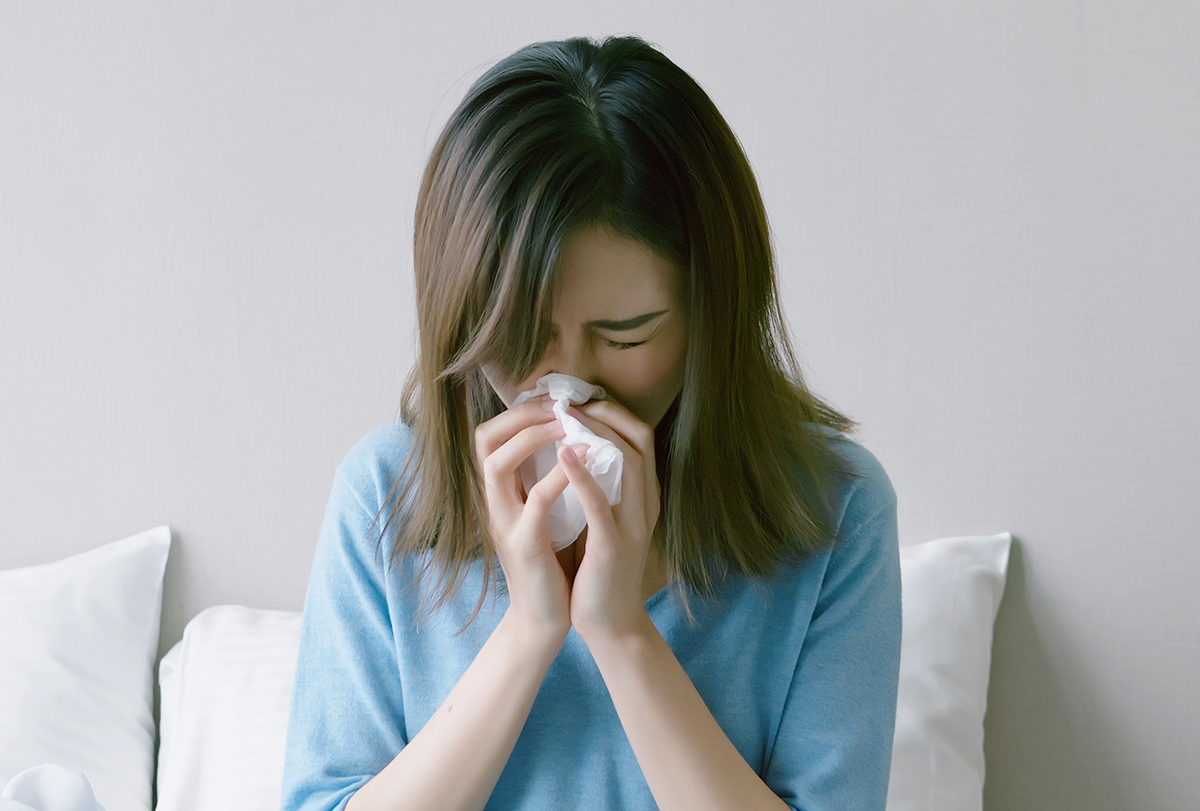
The foreign agents are called allergens, which are usually proteins or glycoproteins (proteins with sugar attached to them), whereas the chemicals that fight them are called antibodies.
The reaction time of your body can vary from a few seconds, such as in the case of pollen allergies, to 24 hours, such as in the case of an allergic reaction to red meat in alpha-gal syndrome.
Although allergic or sensitivity responses are supposed to be protective in nature, they can often lead to some unpleasant symptoms. For instance, exposure to a cat causes sneezing, eye itching, and wheezing, which are not comfortable at all, and the cat most certainly won’t harm your body.
This article brings you all the important pieces of information you should know about allergies and their types, complications, and treatment modalities.
Different Types of Allergies
There are four types of hypersensitivities:
- Type I: immediate
- Type II: cytotoxic
- Type III: immune complex
- Type IV: delayed
Major Causes of Allergies
Allergies are a type I (immediate) hypersensitivity reaction. The allergy response is an otherwise normal immunological response to an inoffensive environmental allergen.
The protecting response is natural, which can have a harmful effect. The immune-mediated response to the allergens causes cross-linkage of immunoglobulin E (IgE) coating mast cells, further resulting in the degranulation of mast cells, releasing histamine and inflammatory mediators.
The manifestations may range from a mild to moderate response, such as rash, hives, erythema, pruritus, and “wheal-and-flare” characterized by redness and bumps in the skin, to more severe anaphylactic reactions, depending on the triggers. (1)(2)
Commonly Reported Signs and Symptoms of Allergies
An allergic reaction usually manifests in the form of the following symptoms:
- Watery eyes
- Pruritus
- Urticaria
- Rashes
- Nasal congestion
- Allergic rhinitis
- Chest tightness
- Shortness of breath
- Swelling of the face, eyes, lips, and tongue
- Abdominal pain, vomiting, and diarrhea
Common Allergens
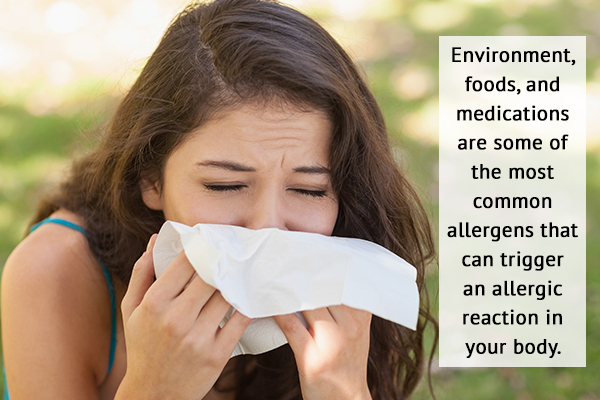
The following are some of the most common allergens that can trigger an allergic reaction in your body.
1. Environmental
Allergies can be to specific indoor allergens, outdoor environmental elements, or similar particles that may cause cross-reactivity. Allergens can be dust mites, animal dander, pollen, cockroaches, mold, and air pollutants. (3)(4) These allergens can further cause asthma, allergic rhinitis, and allergic conjunctivitis.
2. Food
Certain foods can also serve as stimuli, triggering an immune response and causing skin, gastrointestinal, and/or respiratory reactions. Most common trigger foods include: (5)
- Milk
- Eggs
- Peanuts
- Shellfish
- Wheat
- Nuts
- Soy
3. Medication
Medications can produce all four types of hypersensitivity reactions. Common agents include: (6)
- Penicillin
- NSAIDs
- Sulfonamide
- Vaccinations
- Anticonvulsants
- Muscle relaxants
4. Others
Nickel allergies can result in type IV (delayed) hypersensitivity reactions, resulting from repeated exposure to irritants. These differ from the type I (immediate) hypersensitivity reactions discussed earlier.
Nickel products can be found in watches, kitchen utensils, jewelry, earrings, bracelets, necklaces, and therapeutic devices. The allergy can manifest as redness, induration, vesicles, and scaling plaques, which may progress to dryness, scaling, and hyperpigmentation.
ALSO READ: 11 Common Allergy Triggers and How to Avoid Them
Your Body’s Reaction to an Allergen
An allergic reaction occurs when an individual is exposed to an environmental source eliciting a response within the body via the nose, skin, and respiratory and gastrointestinal tracts, causing mild symptoms such as watery eyes, nasal congestion, pruritus, urticaria, rashes, abdominal pain, and vomiting.
Severe allergic reactions include nausea, vomiting, chest tightness, abnormal breathing sounds, difficulty swallowing, palpitations, dizziness, lightheadedness, flushing of the face, unconsciousness, and swelling of the face, eyes, and tongue.
The most common allergens responsible for these reactions include foods such as nuts, fish, and shellfish, alongside other environmental factors such as bee stings, insect bites, medications, and pollen.
The initial exposure to an allergen often elicits a mild response. However, subsequent exposures can lead to severe reactions, often occurring within seconds to minutes while others within hours after exposure.
Ways to Manage an Allergic Reaction
A simple method to manage allergies is to prevent exposure to any known allergens that may cause an allergic reaction.
For instance, individuals allergic to pollen are often advised to stay indoors on a dry windy day. Pollen count is the highest in the morning, so they should refrain from going outdoors during these hours of the day. It is suggested to go outdoors after a rainy day when the majority of pollen is no longer in the air.
Additionally, it is advised to remove outdoor clothing and to immediately shower after arriving home to prevent pollen-induced allergic reactions. Also, pollen has the propensity to adhere to linens, thus these should not be hung outdoors to dry.
Individuals allergic to grass should refrain from doing lawn-related chores such as lawn mowing and gardening. (7)(2)
In case you do begin to show symptoms of an allergic response, you can choose any of the following measures to manage it depending upon the allergen involved, nature of your symptoms, and severity of your reaction.
1. Irrigate nose with saline solution
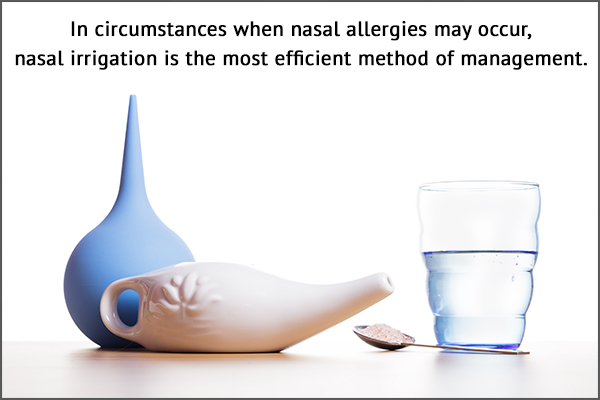
In circumstances when nasal allergies may occur, nasal irrigation is the most efficient method of management. In doing so, toxins, mucus, and the allergens are effectively removed from the nasal passages, leading to immediate relief. (8)
2. Inhale steam
Steam therapy is another beneficial method to relieve allergies. Inhaling steam moistens and relaxes the nasal passages.
Moistening of the mucus within the nose flushes out the mucus, toxins, and allergens concurrently present. Inhaling steam makes it easier to breathe, providing temporary relief.
Directions:
- Heat some water and carefully pour the hot water into a bowl.
- Place a towel over your head while leaning over the bowl of water, keeping a sufficient distance of 8–12 inches. It is important to keep this distance to prevent any burn injuries. Also, no direct contact with the water should be made.
- For 2–5 minutes, inhale in and out with the towel over your head. Steam therapy should not be longer than 10–15 minutes.
- Repeat 2–3 times a day as needed.
An alternative method is to purchase a vaporizer.
3. Use quercetin
Quercetin contains phytonutrients also known as flavonoids in fruits and vegetables. It has properties beneficial for allergy-prone individuals: it is known to stabilize mast cells and thus reduce symptoms of runny nose, watery eyes, and facial swelling. (9)
4. Try acupuncture
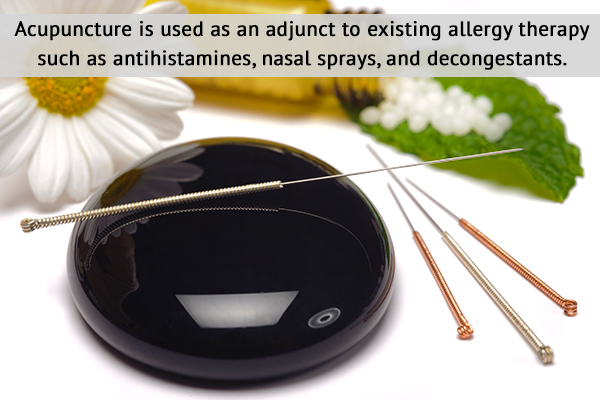
Acupuncture is a traditional Chinese medicine whereby needles are inserted in certain areas of the body known as meridians, which are believed to channel multiple connections throughout the body to alleviate a large sum of medical-related concerns such as allergies.
Acupuncture is used as an adjunct to existing allergy therapy such as antihistamines, nasal sprays, and decongestants. Management includes once or twice a week treatments for several weeks to months depending on the allergy severity, followed by an annual maintenance treatment or as needed.
It is important to discuss management options with your primary care physician. (10)
5. Soak in an oatmeal bath
Studies have indicated that colloidal oatmeal reduces histamine release from mast cells. The USFDA has approved oatmeal baths as safe and helpful in allergy management due to their beneficial properties.
A 15-minute warm oatmeal bath is found to show signs of relief following skin-related allergic reactions. (11)
6. Apply cold compress
Cold compresses are known to alleviate swelling and inflammation and thus are ideal for eye allergies as they can reduce red, puffy eyes.
Cold compresses decrease blood circulation, therefore minimizing the swelling and numbing the pain. It is important to note that this remedy is for short-term relief as eye allergies require first-line treatment such as antihistamines.
Diagnosing Allergies
Common methods for diagnosing allergies are: (12)
- Serum IgE
- Skin prick test
- Patch test
- Intradermal test
- Radioallergosorbent test (RAST; although this test is no longer being used)
Foods to Manage Allergies

Here are some food items that have been studied for their anti-allergic properties, which can help reduce or prevent adverse symptoms altogether.
1. Eat foods rich in vitamin C
Studies have shown that consuming foods rich in vitamin C has greatly improved the health of individuals with allergies. In particular, they have reduced the incidences of allergic rhinitis and pollen-induced allergic reactions in predisposed individuals. (13)
2. Include probiotic-rich foods in the diet
A diet rich in probiotic foods greatly improves allergic rhinitis symptoms. (14) Studies have shown that consumption of lactobacilli and bifidobacteria collectively reduced nasal allergies possibly be due to the probiotics increasing the number of regulatory T cells and potentially reducing hay fever symptoms.
3. Use garlic in cooking
Garlic is known to build immunity, preventing the likelihood of colds and allergies. Incorporating fresh garlic in one’s diet or in capsule form can be used to manage allergies.
Some Preventive Measures Against Allergies
Here are some ways you can avoid a possible allergic reaction or complications associated with an inevitable exposure to an allergen:
- Wear a medical alert necklace or bracelet.
- Individuals at risk of more severe hypersensitivity reactions such as anaphylaxis should carry an epinephrine auto-injector (EpiPen).
- Individuals with known allergies should regularly keep over-the-counter antihistamines, decongestants, and nasal sprays with themselves.
- According to doctor’s orders, one should always carry a bee sting kit.
- Children who are susceptible to food allergies should slowly be introduced to new foods in order to observe any allergic reactions.
- Adults should check food labels before consumption.
What Is Anaphylaxis?

Anaphylaxis is a life-threatening allergic reaction that often occurs within seconds to minutes upon exposure to allergens such as peanuts, tree nuts, fish, shellfish, milk, bee stings, yellow jackets, hornets, fire ants, latex, and certain medications such as antibiotics and aspirin.
Blood pressure rapidly drops, the airways constrict, and the tongue and throat swell, making it difficult to adequately breathe. Additional signs and symptoms often include a rapid weak pulse, dizziness, fainting, a skin rash, nausea, and vomiting.
A history of anaphylaxis, preexisting allergies, and asthma potentiates the likelihood of future anaphylactic reactions. (2)
Most-Asked Questions About Allergies
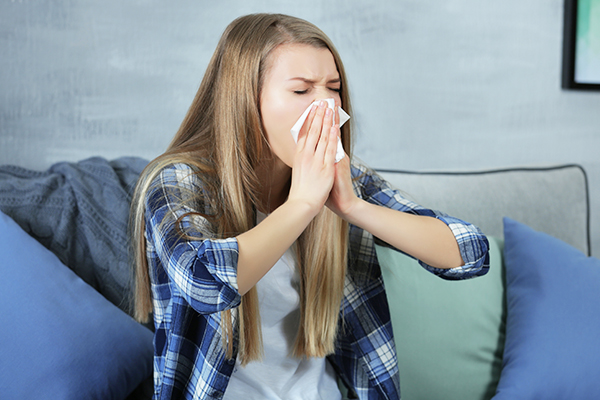
Who are most likely to suffer from allergic reactions?
Anyone at any age can suffer from allergic reactions. Genetically predisposed individuals who have a family history of allergies are more likely to suffer than those without. (15)
Can an allergy be cured permanently?
The prevention of known triggers and allergens (mentioned above) is the main focus of allergy management.
Although there is no permanent cure for allergies, the symptoms can be managed through supportive treatment that can often effectively relieve mild to moderate symptoms. More severe reactions, such as anaphylaxis, prompt immediate medical care.
Final Word
Allergies are common and what triggers an allergic response within your body can lie anywhere on a wide spectrum of possible allergens. It can be something as small as a pollen grain, as common as a yellow jacket wasp, or as strange as meat and medications such as aspirin.
Whatever the reason, such hypersensitivity responses are not pretty. The symptoms can make you highly at unease.
Although there are several ways in which you can manage such discomforting symptoms, you must try to understand the nature of your allergies for a more effective management plan. This involves learning about the nature of different allergens, where they come from, and possible routes of exposure to them.
Educating yourself about these fundamental facts will make it easier for you to avoid allergens and reduce the risk of allergic reactions. You can further discuss these with your doctor and ask him about the ways in which you can dodge allergic reactions in the first place.
- Was this article helpful?
- YES, THANKS!NOT REALLY


